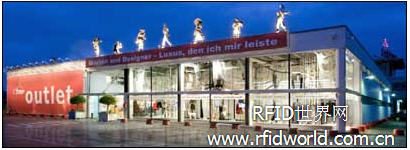
Krause Outlet uses RFID to maximize window shopping
[ad_1]
Krause Outlet, a clothing retail store in northeastern Germany, uses RFID to implement an automatic clothing show in the shop window 24 hours a day. Shoppers can use their mobile phones to book their favorite clothing and purchase them through vending machines.
Erwin Krause is the owner of Krause Outlet, which specializes in selling men’s and women’s branded clothing purchased from retailers eager to reduce inventory. Unlike ordinary stores, the clothes sold by Krause are often broken or incomplete in color. Before the adoption of RFID, customers had to wait up to two weeks before purchasing a certain piece of clothing displayed in the window. The clerk manually records the shopper’s name and phone number. When the garment is taken out of the window and is ready for sale, the clerk calls the intended customer again. Krause realized that this approach was very detrimental to sales 10 years ago, and had always dreamed of a system that would allow the store windows to continuously display different clothes.

Krause Outlet
Fortunately, Krause’s neighbor, Wilhelm Stock, happens to be an automatic technology expert for a large energy company. They discussed the development of related systems with Duerkopp, a manufacturer of an automated rack in Bielefeld.
When Krause moved into a new building in an industrial zone in Düren in 2005, Krause and Stock started to implement this idea, and the system was fully operational at the end of 2008.
When shoppers do window shopping at Krause Outlet, they stay longer than expected. What shoppers see is not the usual mannequins or folded clothes, but the clothes moving on a 56-meter-long automatic rack, where the designer clothes are 2.4 meters away from each other.
When a piece of clothing (such as a Hugo Boss jacket or top) arrives at the window, the automatic hanger stops, rotates the clothing 180 degrees, and a nearby RFID reader reads the passive high-frequency tag on the clothing. The ID code of the tag corresponds to the item’s data and pictures, which are displayed on a computer screen in the shop window. Customers can learn about the size, brand and original price of the clothes, as well as the price of Krause Outlet and the four-digit code for ordering this set of clothes.

When a piece of clothing arrives at the shop window, a computer screen in the shop window displays information and pictures of the clothing
If the customer wants to buy or order this piece of clothing, he can call an automatic hotline and follow the prompts to enter the code assigned to this piece of clothing.
Then, the computer system instructs the hanger to remove the clothes, reserve them or sell them to customers immediately. The system will automatically replace this piece of clothing with other items waiting to be exhibited. The dress moves along the ring-shaped hanger and reaches the joint of the reserved clothes. Here, the RFID tags of the clothes are read again, and then the automatic system moves the clothes to a reserved storage area. Customers have two working days to purchase reserved clothes.
If a shopper wants to buy clothes immediately, he can purchase them through an automatic vending system: After ordering clothes, the customer uses his bank card to open a security door leading to a front hall where Krause installs a similar automatic teller machine Touch screen. The shopper inserts the bank card into the machine and follows the prompts to view the information of the ordered clothes, and then make a purchase.
When the customer completes the payment, the computer system prompts the hanger to move the clothes to a delivery door in the front hall. The reader reads the clothes label, opens the internal glass door, the automatic hanger moves the clothes to the delivery position, and then closes the internal door. After a few seconds, the outer door opens and shoppers can take the clothes.

Users buy clothing immediately through automatic clothing vending machines
So far, Krause has not provided a place for shoppers to try on clothes, and any return of clothes must be completed during normal working hours. If the customer returns the RFID tag to the store, they will get a refund of 50 cents.
Customers who buy clothes online can also use the RFID system. Krause has designed a website where customers can click on the picture, view the four-digit code, and then place an order through the automated system. The workflow is consistent with the offline order.
The tag’s operating frequency is 13.56 MHz, using a proprietary air interface protocol. When Krause designed this system, EPC Gen 2 had not yet become an industry standard. Krause uses 2000 tags from X-Ident Technology. The reader and antenna are provided by Feig Electronic. The label is the size of a credit card and is tied to the clothing with a plastic thread.
When labeling, the unique ID code of the RFID label corresponds to the barcode ID of the paper label in the store database.
If Krause eventually expands the application to all 50,000 items in the warehouse, they will adopt EPC Gen 2 tags. Although it is too early to talk about the return on investment, this application has worked well so far, and Krause is very satisfied.
[ad_2]



